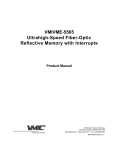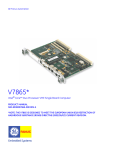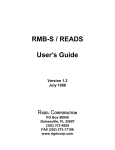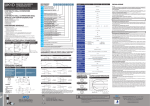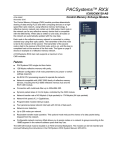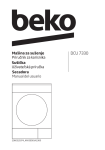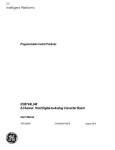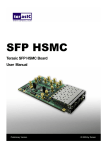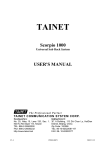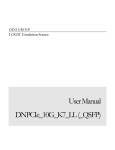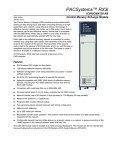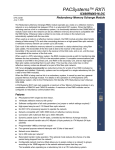Download VMIACC-5595 2Gb/s Reflective Memory Hub Assembly Installation
Transcript
VMIACC-5595 2Gb/s Reflective Memory Hub Assembly Installation Guide (256) 880-0444 w 12090 South Memorial Parkway Huntsville, Alabama 35803-3308, USA (800) 322-3616 w Fax: (256) 882-0859 522-805595-000 Rev. A (256) 880-0444 w 12090 South Memorial Parkway Huntsville, Alabama 35803-3308, USA (800) 322-3616 w Fax: (256) 882-0859 COPYRIGHT AND TRADEMARKS © Copyright 2003. The information in this document has been carefully checked and is believed to be entirely reliable. While all reasonable efforts to ensure accuracy have been taken in the preparation of this manual, VMIC assumes no responsibility resulting from omissions or errors in this manual, or from the use of information contained herein. VMIC reserves the right to make any changes, without notice, to this or any of VMIC’s products to improve reliability, performance, function, or design. VMIC does not assume any liability arising out of the application or use of any product or circuit described herein; nor does VMIC convey any license under its patent rights or the rights of others. For warranty and repair policies, refer to VMIC’s Standard Conditions of Sale. AMXbus, BITMODULE, COSMODULE, DMAbus, IOMax, IOWorks Foundation, IOWorks Manager, IOWorks Server, MAGICWARE, MEGAMODULE, PLC ACCELERATOR (ACCELERATION), Quick Link, RTnet, Soft Logic Link, SRTbus, TESTCAL, “The Next Generation PLC”, The PLC Connection, TURBOMODULE, UCLIO, UIOD, UPLC, Visual Soft Logic Control(ler), VMEaccess, VMEbus Access, VMEmanager, VMEmonitor, VMEnet, VMEnet II, and VMEprobe are trademarks and The I/O Experts, The I/O Systems Experts, The Soft Logic Experts, and The Total Solutions Provider are service marks of VMIC. (I/O man figure) (IOWorks man figure) The I/O man figure, IOWorks, IOWorks man figure, UIOC, Visual IOWorks and the VMIC logo are registered trademarks of VMIC. ActiveX, Microsoft, Microsoft Access, MS-DOS, Visual Basic, Visual C++, Win32, Windows, Windows NT, and XENIX are registered trademarks of Microsoft Corporation. Celeron and MMX are trademarked, Intel and Pentium are registered trademarks of Intel Corporation. PICMG and CompactPCI are registered trademarks of PCI Industrial Computer Manufacturers’ Group. Other registered trademarks are the property of their respective owners. VMIC All Rights Reserved This document shall not be duplicated, nor its contents used for any purpose, unless granted express written permission from VMIC. (256) 880-0444 w 12090 South Memorial Parkway Huntsville, Alabama 35803-3308, USA (800) 322-3616 w Fax: (256) 882-0859 Table of Contents List of Figures . . . . . . . . . . . . . . . . . . . . . . . . . . . . . . . . . . . . . . . . . . . . . . . . . . . . . . . . . . . . . . . . . . . . . 7 Overview . . . . . . . . . . . . . . . . . . . . . . . . . . . . . . . . . . . . . . . . . . . . . . . . . . . . . . . . . . . . . . . . . . . . . . . . . . 9 Features: . . . . . . . . . . . . . . . . . . . . . . . . . . . . . . . . . . . . . . . . . . . . . . . . . . . . . . . . . . . . . . . . 10 Reference Material List. . . . . . . . . . . . . . . . . . . . . . . . . . . . . . . . . . . . . . . . . . . . . . . . . . . . . . . . . . . . 12 Physical Description and Specifications. . . . . . . . . . . . . . . . . . . . . . . . . . . . . . . . . . . . . . . . . . . . 12 Safety Summary . . . . . . . . . . . . . . . . . . . . . . . . . . . . . . . . . . . . . . . . . . . . . . . . . . . . . . . . . . . . . . . . . 13 Ground the System . . . . . . . . . . . . . . . . . . . . . . . . . . . . . . . . . . . . . . . . . . . . . . . . . . . . . . . . . . . 13 Do Not Operate in an Explosive Atmosphere . . . . . . . . . . . . . . . . . . . . . . . . . . . . . . . . . . . . . . . 13 Keep Away from Live Circuits . . . . . . . . . . . . . . . . . . . . . . . . . . . . . . . . . . . . . . . . . . . . . . . . . . . 13 Do Not Service or Adjust Alone . . . . . . . . . . . . . . . . . . . . . . . . . . . . . . . . . . . . . . . . . . . . . . . . . . 13 Do Not Substitute Parts or Modify System. . . . . . . . . . . . . . . . . . . . . . . . . . . . . . . . . . . . . . . . . . 13 Dangerous Procedure Warnings . . . . . . . . . . . . . . . . . . . . . . . . . . . . . . . . . . . . . . . . . . . . . . . . . 13 Safety Symbols Used in This Manual . . . . . . . . . . . . . . . . . . . . . . . . . . . . . . . . . . . . . . . . . . . . . . . . . 14 Chapter 1 - Theory of Operation . . . . . . . . . . . . . . . . . . . . . . . . . . . . . . . . . . . . . . . . . . . . . . . . . . . . . . 15 Basic Operation . . . . . . . . . . . . . . . . . . . . . . . . . . . . . . . . . . . . . . . . . . . . . . . . . . . . . . . . . . . . . . 15 Front Panel Description . . . . . . . . . . . . . . . . . . . . . . . . . . . . . . . . . . . . . . . . . . . . . . . . . . . . . . . . . . . 17 Auxiliary Manual Switch (S4) . . . . . . . . . . . . . . . . . . . . . . . . . . . . . . . . . . . . . . . . . . . . . . . . . . . . 17 Front Panel Status Indicators, Switches and Ports . . . . . . . . . . . . . . . . . . . . . . . . . . . . . . . . . . . 20 Rear Panel . . . . . . . . . . . . . . . . . . . . . . . . . . . . . . . . . . . . . . . . . . . . . . . . . . . . . . . . . . . . . . . . . . 20 Fuse Type:. . . . . . . . . . . . . . . . . . . . . . . . . . . . . . . . . . . . . . . . . . . . . . . . . . . . . . . . . . . . . . . 21 Cascading. . . . . . . . . . . . . . . . . . . . . . . . . . . . . . . . . . . . . . . . . . . . . . . . . . . . . . . . . . . . . . . . . . . . . . 22 Fiber-Optic Cable and Connector Description . . . . . . . . . . . . . . . . . . . . . . . . . . . . . . . . . . . . . . . . . . 25 Cable Specification: . . . . . . . . . . . . . . . . . . . . . . . . . . . . . . . . . . . . . . . . . . . . . . . . . . . . . . . . 25 Connector Specification: . . . . . . . . . . . . . . . . . . . . . . . . . . . . . . . . . . . . . . . . . . . . . . . . . . . . 25 Cable Length Specification: . . . . . . . . . . . . . . . . . . . . . . . . . . . . . . . . . . . . . . . . . . . . . . . . . . 25 Using the RS-232 Serial Port . . . . . . . . . . . . . . . . . . . . . . . . . . . . . . . . . . . . . . . . . . . . . . . . . . . . 27 5 VMIACC-5595 2Gb/sec. Reflective Memory Hub Assembly RS-232 Serial Port . . . . . . . . . . . . . . . . . . . . . . . . . . . . . . . . . . . . . . . . . . . . . . . . . . . . . . . . 28 Using the Ethernet Port (LAN) . . . . . . . . . . . . . . . . . . . . . . . . . . . . . . . . . . . . . . . . . . . . . . . . . . 29 Ethernet Port . . . . . . . . . . . . . . . . . . . . . . . . . . . . . . . . . . . . . . . . . . . . . . . . . . . . . . . . . . . . 30 Operational Software Description . . . . . . . . . . . . . . . . . . . . . . . . . . . . . . . . . . . . . . . . . . . . . . . . . . . 31 RS-232 Serial Port Control Utility . . . . . . . . . . . . . . . . . . . . . . . . . . . . . . . . . . . . . . . . . . . . . . . . 31 Ethernet Port Graphical User Interface (GUI) . . . . . . . . . . . . . . . . . . . . . . . . . . . . . . . . . . . . . . . 38 Detect Mode Options . . . . . . . . . . . . . . . . . . . . . . . . . . . . . . . . . . . . . . . . . . . . . . . . . . . . . . . . . 41 Bypass Control Options . . . . . . . . . . . . . . . . . . . . . . . . . . . . . . . . . . . . . . . . . . . . . . . . . . . . . . . 43 Transmit Control Options . . . . . . . . . . . . . . . . . . . . . . . . . . . . . . . . . . . . . . . . . . . . . . . . . . . . . . 44 Communication Settings . . . . . . . . . . . . . . . . . . . . . . . . . . . . . . . . . . . . . . . . . . . . . . . . . . . . . . . 45 Maintenance . . . . . . . . . . . . . . . . . . . . . . . . . . . . . . . . . . . . . . . . . . . . . . . . . . . . . . . . . . . . . . . . . . . . . . 47 Maintenance . . . . . . . . . . . . . . . . . . . . . . . . . . . . . . . . . . . . . . . . . . . . . . . . . . . . . . . . . . . . . . . . . . . 47 Maintenance Prints . . . . . . . . . . . . . . . . . . . . . . . . . . . . . . . . . . . . . . . . . . . . . . . . . . . . . . . . . . . . . . 48 6 List of Figures Figure 1 VMIACC-5595 Hub Assembly .................................................................................................. 10 Figure 2 VMIACC-5595 Functional Block Diagram ................................................................................. 11 Figure 1-1 VMIACC-5595 Front Panel ...................................................................................................... 17 Figure 1-2 Location of User Configurable Jumper (E4) and Switch S4 ...................................................... 19 Figure 1-3 Auxiliary Manual Switch ............................................................................................................ 19 Figure 1-4 VMIACC-5595 Rear Panel ........................................................................................................ 21 Figure 1-5 Example of Three VMIACC-5595s Cascaded with up to 21 Nodes using Simplex Cables ...... 23 Figure 1-6 Example of Three VMIACC-5595s Cascaded with up to 20 Nodes using Duplex Cables ........ 24 Figure 1-7 ‘LC’ Type Multimode Fiber-Optic Cable Connector .................................................................. 25 Figure 1-8 Fiber-Optic Cable with Pluggable Transceiver .......................................................................... 26 Figure 1-9 VMIACC-5595 RS-232 Serial Port Setup 27 Figure 1-10 RS-232 Connector Pin Assignment Figure 1-11 VMIACC-5595 Typical Ethernet Setup Figure 1-12 Ethernet Port and Pin Locations ................................................................................. .......................................................................................... 28 ..................................................................................... 29 ............................................................................................... 30 Figure 1-13 Desktop Window ....................................................................................................................... 31 Figure 1-14 Hyperterminal New Connection Window 32 Figure 1-15 COM Port Window Figure 1-16 COM1 Property Window ........................................................................................................... 34 Figure 1-17 Control Utility Logon Window .................................................................................................... 35 Figure 1-18 Control Utility Status Window .................................................................................................... 36 Figure 1-19 Control Utility Port Settings ....................................................................................................... 37 Figure 1-20 Example: Communications Settings ......................................................................................... 37 Figure 1-21 VMIACC-5595 Ethernet Port GUI Logon Screen ...................................................................... 38 Figure 1-22 User Name and Password Screen ............................................................................................ 39 Figure 1-23 VMIACC-5595 Main Screen ...................................................................................................... 40 Figure 1-24 Detect Mode Options Menu 41 Figure 1-25 Bypass Control Options Menu .................................................................................. .................................................................................................................... 33 ...................................................................................................... .................................................................................................. 43 7 VMIACC-5595 2Gb/s Reflective Memory Hub Assembly Figure 1-26 Transmit Control Options Menu ................................................................................................ 44 Figure 1-27 VMIACC-5595 Communication Screen .................................................................................... 45 Figure 1-28 Change Password Screen ........................................................................................................ 46 8 Overview Contents Reference Material List . . . . . . . . . . . . . . . . . . . . . . . . . . . . . . . . . . . . . . . . . . . . . . . . . . . 12 Safety Summary . . . . . . . . . . . . . . . . . . . . . . . . . . . . . . . . . . . . . . . . . . . . . . . . . . . . . . . . 13 Safety Symbols Used in This Manual . . . . . . . . . . . . . . . . . . . . . . . . . . . . . . . . . . . . . . 14 Introduction The VMIACC-5595 is a managed hub, designed to operate with VMIC’s VMIxxx-5565 Reflective Memory products. Without a hub device, the Reflective Memory nodes must be networked together in a daisy-chained loop. In the hub-less configuration if one node becomes inoperable, the entire loop becomes disabled. When the VMIACC-5595 hub is incorporated into the network, the network is converted from a loop to a star configuration. In the star configuration if one node becomes inoperative, that node is bypassed by the VMIACC-5595 and the remaining nodes on the network remain operational. When a network consists of a large number of nodes or if the nodes are widely dispersed over an area, the star configuration is easier to build and maintain. The VMIACC-5595 automatically bypasses a port when it detects a loss of signal or the absence of a valid synchronization pattern, allowing the remaining nodes to continue to operate. Each port on the VMIACC-5595 regenerates the serial optical signal, eliminating problems with insertion losses and cable attenuation. Signal regeneration also reduces jitter. The optical ports are implemented with Small Form-Factor Pluggable (SFP) transceivers (see Figure 1 on page 10). Only the required ports need to be populated. The SFP transceivers can be a mix of multimode (short distance) or single-mode (long distance) transceivers. This feature permits a cost savings in small networks, as well as system optimization. For larger networks, several VMIACC-5595 hubs can be cascaded, permitting a managed hub array with up to 256 nodes. An RS-232 port permits local monitoring and control of the Reflective Memory network using a standard PC serial port. The Ethernet port (10BaseT) can be used to 9 2Gb/sec. Reflective Memory Hub Assembly monitor and control the hub from great distances through a Local Area Network (LAN) or with the use of a Web browser. The VMIACC-5595 is available as a 19-inch 1U rack mountable enclosure or as a desktop enclosure. The universal power supply permits operation with nearly any international power standard. Figure 2 on page 11 is a functional block diagram of the VMIACC-5595 Hub Assembly. The VMIACC-5595 can operate without the use of the Ethernet port or the RS-232 port. When first activated, the VMIACC-5595 operates using the factory default configuration with each optical port in the auto bypass mode and the bypass is based on detection of Loss of Signal (LOS). Features: • Designed for use with VMIC’s VMIxxx-5565 Reflective Memory products • Provides up to 8 ports per hub assembly using Small Form-Factor Pluggable (SFP) transceivers • Hub assemblies can be cascaded up to the maximum 256 node limit • Automatically bypasses disabled or disconnected nodes in a fiber-optic network • Automatic bypass controlled by the loss of signal or by the loss of sync pattern • Each port regenerates the serial optical signal to eliminate link losses and to reduce jitter • 10Base-T Ethernet TCP/IP port for remote access and control • RS-232 port for local access and control • Available as either a 19-inch 1U rack mount or desktop enclosure • Internal universal power supply LAN LNK VMIA C 559 C 5 ACT 10Ba se-T RS-2 32 STAT US R 5 3 RST GAN 1x8- G 2x4 Port 0 BP SD SY Optional 1U Rack Mounting Hardware (Set of two) Port 1 BP SD SY Port 2 BP SD SY Port 3 BP SD SY Up to eight Transceivers can be Installed Port 4 BP SD SY Port 5 BP SD SY Port 6 BP SD SY Port 7 BP SD SY Feet for Desktop Option (Set of Four) Figure 1 VMIACC-5595 Hub Assembly 10 VMIxxx-5565 VMIxxx-5565 VMIxxx-5565 VMIxxx-5565 VMIxxx-5565 VMIxxx-5565 VMIxxx-5565 SFP0 SFP1 SFP2 SFP3 SFP4 SFP5 SFP6 SFP7 TRANSCEIVER TRANSCEIVER TRANSCEIVER TRANSCEIVER TRANSCEIVER TRANSCEIVER TRANSCEIVER TRANSCEIVER Figure 2 VMIACC-5595 Functional Block Diagram SYNC DETECT UNIT 0 SYNC DETECT UNIT 1 1 SYNC DETECT UNIT 2 1 SYNC DETECT UNIT 3 1 SYNC DETECT UNIT 4 1 SYNC DETECT UNIT 5 1 SYNC DETECT UNIT 6 1 SYNC DETECT UNIT 7 1 1 MUX0 MUX1 MUX2 MUX3 MUX4 MUX5 MUX6 MUX7 0 0 0 0 0 0 0 0 MUX8 1 VMIxxx-5565 MUX9 0 1 0 STATUS & CONTROL VMIACC-5595 ENCLOSURE 10 BASE-T ETHERNET PORT RS-232 PORT ETHERNET RS-232 RESET SWITCH GANGE SELECT SWITCH UNIVERSAL POWER SUPPLY POWER SWITCH, FUSE, IEC RECEPTACLE 90-264 VAC 47-440 Hz (REAR PANEL) Overview 11 2Gb/sec. Reflective Memory Hub Assembly Reference Material List Refer to Rabbit Semiconductor’s “Rabbit 2000 Microprocessor User’s Manual” Document # 019-0069 011205 for a detailed explanation of the Rabbit 2000 Microprocessor, available from the following source: Rabbit Semiconductor 2932 Spafford St. Davis, CA 95616 (530) 757-8400 FAX: (530) 757-8402 www.rabbitsemiconductor.com Refer to Rabbit Semiconductor’s “Rabbit Ethernet Module User’s Manual” for a detailed explanation of the Rabbit Ethernet Module available from the following source: Rabbit Semiconductor 2932 Spafford St. Davis, CA 95616 (530) 757-8400 FAX: (530) 757-8402 www.rabbitsemiconductor.com Refer to the VMIxxx-5565 “Reflective Memory Product Manuals” for a detailed explanation of the Reflective Memory available from the following source: VMIC 12090 South Memorial Pkwy. Huntsville, AL 35803-3308, USA (256) 880-0444 (800) 322-3616 FAX: (256) 882-0859 www.vmic.com Physical Description and Specifications Refer to 800-805595-000 specification available from VMIC. VMIC 12090 South Memorial Pkwy. Huntsville, AL 35803-3308, USA (256) 880-0444 (800) 322-3616 FAX: (256) 882-0859 www.vmic.com 12 Overview Safety Summary The following general safety precautions must be observed during all phases of the operation, service, and repair of this product. Failure to comply with these precautions or with specific warnings elsewhere in this manual violates safety standards of design, manufacture and intended use of this product. VMIC assumes no liability for the customer’s failure to comply with these requirements. Ground the System To minimize shock hazard, the chassis and system cabinet must be connected to an electrical ground. A three-conductor AC power cable should be used. The power cable must either be plugged into an approved three-contact electrical outlet or used with a three-contact to two-contact adapter with the grounding wire (green) firmly connected to an electrical ground (safety ground) at the power outlet. Do Not Operate in an Explosive Atmosphere Do not operate the system in the presence of flammable gases or fumes. Operation of any electrical system in such an environment constitutes a definite safety hazard. Keep Away from Live Circuits Operating personnel must not remove product covers. Component replacement and internal adjustments must be made by qualified maintenance personnel. Do not replace components with power cable connected. Under certain conditions, dangerous voltages may exist even with the power cable removed. To avoid injuries, always disconnect power and discharge circuits before touching them. Do Not Service or Adjust Alone Do not attempt internal service or adjustment unless another person, capable of rendering first aid and resuscitation, is present. Do Not Substitute Parts or Modify System Because of the danger of introducing additional hazards, do not install substitute parts or perform any unauthorized modification to the product. Return the product to VMIC for service and repair to ensure that safety features are maintained. Dangerous Procedure Warnings Warnings, such as the example below, precede only potentially dangerous procedures throughout this manual. Instructions contained in the warnings must be followed. STOP: Dangerous voltages, capable of causing death, are present in this system. Use extreme caution when handling, testing and adjusting. 13 2Gb/sec. Reflective Memory Hub Assembly Safety Symbols Used in This Manual STOP: informs the operator the that a practice or procedure should not be performed. Actions could result in injury or death to personnel, or could result in damage to or destruction of part or all of the system. WARNING: denotes a hazard. It calls attention to a procedure, a practice, a condition, which, if not correctly performed or adhered to, could result in injury or death to personnel. CAUTION: denotes a hazard. It calls attention to an operating procedure, a practice, or a condition, which, if not correctly performed or adhered to, could result in damage to or destruction of part or all of the system. NOTE: denotes important information. It calls attention to a procedure, a practice, a condition or the like, which is essential to highlight. 14 CHAPTER 1 Theory of Operation Contents Front Panel Description . . . . . . . . . . . . . . . . . . . . . . . . . . . . . . . . . . . . . . . . . . . . . . 17 Cascading . . . . . . . . . . . . . . . . . . . . . . . . . . . . . . . . . . . . . . . . . . . . . . . . . . . . . . . . . . 22 Fiber-Optic Cable and Connector Description . . . . . . . . . . . . . . . . . . . . . . . . . . . 25 Operational Software Description . . . . . . . . . . . . . . . . . . . . . . . . . . . . . . . . . . . . . . 31 Basic Operation With the default factory configuration, the VMIACC-5595 automatically bypasses ports due to the loss of a signal (light) at the receiver or the absence of a valid synchronization pattern, without any interface through the Ethernet port or RS-232 port. Three LEDs adjacent to each port give a visual indication of the port status. Status information and modes of operation are available using the Ethernet port and your standard Web Browser or using the RS-232 port and any RS-232 terminal interface. Status information includes: • Detection of installed transceivers • Detection of signal (light) • Detection of valid synchronization patterns (multiple or single) The Hub Assembly allows for the bypassing of a port to be based on the absence of either single/multiple synchronization patterns or the loss of a signal (light). Also, each port can be manually forced active or bypassed regardless of the status indicators. Finally, each port transmitter can individually be disabled without shutting down the entire Hub. Both the serial port interface and the Ethernet interface can be used at the same time. Multiple Ethernet users are also possible. At times this feature is actually useful. It can be tedious to temporarily change your PC’s Ethernet port to a range that matches the default factory settings, if restoring the defaults becomes necessary. On some machines, it could require a time consuming multi-reboot process. By using the serial port only to re-establish the IP settings, the process becomes easier. 15 1 VMIACC-5595 2Gb/sec. Reflective Memory Hub Assembly The total signal propagation delay through the entire VMIACC-5595 hub is 25 nanoseconds — equivalent to the delay through approximately 18 feet of cable. The switching time depends on the Detection Mode used: LOS, Single Sync mode or Multi-Sync mode. For the Single Sync Detect Mode, the auto bypass switch delay will be approximately 0 to 15.5 µsec. For the Multi-Sync mode, the auto bypass switch delay is approximately 4 times 15.5 µsec or 62 µsec provided four consecutive invalid sync periods occur. The auto bypass ON switching delay for the LOS Detect Mode is approximately 100 µsec. The auto bypass OFF switching delay for the LOS Detect Mode is approximately 350 µsec. NOTE: The switching time values are difficult to measure accurately, so they are estimated and based on component specifications. The power up delay of the VMIACC-5595 is less than 2 seconds. This is measured from the time power is first applied to the time the Ethernet Link light is truly asserted. The last event to complete at power up is the boot of the Ethernet module’s imbedded processor. The optical ports are operational in the default mode (auto bypass based on LOS) in approximately 1 second after power is applied. The bypass circuitry of this hub is not passive. Power must be applied to the unit before it will pass network data. All the control settings, not just the communication settings, are stored in non-volatile memory. If power is lost or interrupted, the hub will return to the last good configuration, once the processor boot cycle is complete. 16 Front Panel Description 1 Front Panel Description Status LEDs Ethernet Port (LAN) LAN LNK ACT RS-232 STATUS R 5 VMIACC 5595 PORT 0 RST SPEED GANG 1G-2G 1x8-2x4 3 TX RX BP SD SY PORT 1 TX RX BP SD SY PORT 2 TX RX BP SD SY PORT 3 TX RX BP SD SY PORT 4 TX RX BP SD SY PORT 5 TX RX BP SD SY PORT 6 TX RX BP SD SY PORT 7 TX RX BP SD SY 10Base-T RS-232 Serial Port Reset Switch Gang Select Switch Eight Transceiver Ports Figure 1-1 VMIACC-5595 Front Panel LAN - This is the 10Base-T Ethernet port, using a standard RJ-45 receptacle. The connector has two LEDs along its top edge. The LED labeled LNK is the link status and the LED label ACT is the link activity. The Ethernet interface is compliant with the Transmission Control Protocol/Internet Protocol (TCP/IP) specification. Each hub assembly has a unique Internet Protocol (IP) address that can be altered by the user (see Figure 1-2 on page 19 for the location of the switch) or reset to the default settings. The hub assembly can operate on either a Local Area Network (LAN) or Wide Area Network (WAN). RS-232 – RS-232 is a PC compatible standard female DB9 serial port, supporting baud rates up to 19.2kbps. The RS-232 port is used for local monitoring and control of the hub. Depending on the application, it can also be used as the primary control port. Auxiliary Manual Switch (S4) Switch S4 is a bank of four dip switches located on the circuit board of the VMIACC-5595 (see Figure 1-2 and Figure 1-3 on page 19). The dip switch is used to restore the hub to the default settings. NOTE: If the user forgets the login password or if the hub communication settings are changed in such a way that the user can no longer communicate with the unit, then S4 auxiliary manual dip switch is used to restore the hub to its default configuration values. 17 1 VMIACC-5595 2Gb/sec. Reflective Memory Hub Assembly For each of the four dip switches, only position number 1 is used, the other three are reserved. When the switch is in the “OFF” position, the corresponding direct I/O signal will read high (1). Likewise, when the switch is in the “ON” position, the corresponding direct I/O signal will read low (0). Table 1-1 below lists the dip switch number and description. Table 1-1 Switch S4 Configuration Dip Switch No. Description Action 1 Configuration Settings Restore 2 Reserved 3 Reserved 4 Reserved To restore the factory default configuration, place switch S4 position 1 to the ON position and then cycle the power or press the reset button. Each time the unit leaves reset and senses that switch S4 position 1 is in the ON position, it will restore the unit settings to the factory default values. The default values are: • Password is “password” • IP address is 10.0.0.1 • IP netmask is 255.255.255.0 • IP gateway is 0.0.0.0 • Serial port baud rate is 9600 • Transmitters are enabled • All ports operate in the auto bypass mode • All ports are bypass based on Lost of Signal (LOS) detection CAUTION: Do not leave switch S4 in the ON position indefinitely. Otherwise, every time the unit is reset or power cycled the unit will revert to the defaults settings and your desired configuration will be lost. Jumper E4 is for factory use only. Leave the jumper shunt of E4 between pins 1 and 2. Both the serial and the Ethernet port will not operate if the E4 jumper is altered. 18 Front Panel Description 1 Switch S4 2 3 4 1 LAN VMIA C 559 C 5 LNK CT RS-232 10Bas e-t 1G-2G VMIA C 559 C 5 1x8-2 x4 TX RX BP SD SY LA LNK N TX RX BP SD SY ACT RS-23 2 TX RX BP SD SY STAT US 10Bas e-t R 5 3 RST SPEED 1G-2G GANG 1x8-2 x4 PORT TX TX RX BP SD SY TX RX BP SD SY 0 PORT RX BP SD SY TX TX RX BP SD SY 1 PORT RX BP SD SY TX TX RX BP SD SY 2 PORT RX BP SD SY TX TX RX BP SD SY 3 RX PORT BP SD SY TX 4 PORT RX BP SD SY TX 5 RX PORT BP SD SY TX 6 RX PORT BP SD SY TX 7 RX BP SD SY Figure 1-2 Location of User Configurable Jumper (E4) and Switch S4 OFF ON 1 2 3 4 Default State: All switch positions OFF. Only position #1 is used to reset the Hub to the default settings. Figure 1-3 Auxiliary Manual Switch 19 1 VMIACC-5595 2Gb/sec. Reflective Memory Hub Assembly Front Panel Status Indicators, Switches and Ports Status LEDs – The Status LEDs provide a limited status of the hub. See Table 1-2 below for a description of the status LEDs: Table 1-2 Status LED Descriptions LED Color Description Action R Red Reset This LED is ON when power up/reset or the manual reset is active 5 Yellow 5.0 VDC This LED is ON when 5.0 VDC power is present 3 Green 3.3 VDC This LED is ON when 3.3 VDC power is present RST – RST is a manual push button reset switch, which will reset the entire VMIACC-5595 hub including the 10Base-T Ethernet module. GANG 1x8-2x4 – The GANG switch configures the hub as either 1 group of 8 ports (labeled 1x8) or 2 groups of 4 ports (labeled 2x4). When operating in the 2x4 configuration, ports 0 through 3 form one group and ports 4 through 7 form the second group. The two groups of ports operate independent of each other. To select either setup move the switch either left or right. Moving the switch to the right sets the hub to 2x4, moving the switch to the left sets the hub for 1x8. PORTs 0 through 7 – There are eight positions available for the optical Small Form-Factor Pluggable (SFP) transceivers. Each port can contain an actual transceiver, depending on the option ordered. Ports that do not have a transceiver installed will have a filler plug to avoid dust contamination and reduce EMI emissions, and will automatically be bypassed. The SFP transceivers accept the standard LC type fiber-optic connectors, either the simplex (single) or duplex (double) configuration. The LC receptacle labeled TX is the transmitter and the receptacle labeled RX is the receiver. Port Status LEDs - The three LEDs to the right of each port indicate the current status of that port. See Table 1-3 below for a detail description of the Port Status LEDs. Table 1-3 Port Status LEDs LED Color Description Action BP Red Bypass LED This LED is ON when the port is being bypassed. SD Yellow Signal Detect This LED is ON when the port receiver detects a valid optical signal. SY Green Sync This LED is ON when the port receiver detects valid network sync patterns. Rear Panel The rear panel has a power entry module which includes a power ON/OFF switch, a 1A/250 V fuse and a globally accepted IEC power receptacle. See Figure 1-4 below for the location of the ON/OFF switch and the fuse. 20 Front Panel Description 1 1A/250V Fuse ON/OFF Switch IEC PWR Receptacle Figure 1-4 VMIACC-5595 Rear Panel Fuse Type: 5 x 20mm, fast-acting, IEC 60127-2 standard glass 1A, 250V. Littelfuse part Number 217001 or equivalent. 21 1 VMIACC-5595 2Gb/sec. Reflective Memory Hub Assembly Cascading To create a star network configuration greater than 8 nodes, two or more VMIACC-5595 hubs can be cascaded. Cascading of up to 256 nodes is the limit. This is due to each node having a unique node ID, ranging from 0 through 255. Any port on the VMIACC-5595 can be cabled to another VMIACC-5595 to form the cascade. However, it is best to establish some convention to keep track of the port destinations. When connecting more than two hubs together, VMIC recommends using simplex cables. Simplex cables will not sacrifice an additional port with each cascaded hub. Figure 1-5 on page 23 and Figure 1-6 on page 24 illustrate three cascaded VMIACC-5595 hubs. Figure 1-5 on page 23 shows simplex cables cascading the hubs, with 21 ports available for networking. Figure 1-6 on page 24 shows duplex cables cascading the hubs and has only 20 ports available for networking. Duplex cables are used in both examples, interconnecting the VMIACC-5595 with the VMIxxx-5565 Reflective Memory boards. 22 LAN LNK ACT RS-232 STATUS R VMIACC 5595 PORT 0 RST GANG 1x8-2x4 TX RX 3 PORT 1 TX RX BP SD SY PORT 2 TX RX BP SD SY PORT 3 TX RX BP SD SY PORT 4 TX RX BP SD SY PORT 5 TX RX BP SD SY PORT 6 TX RX BP SD SY PORT 7 TX RX BP SD SY BP SD SY 10Base-T RX RX TX RX TX RX TX RX TX RX TX RX TX TX Node 1 Node 2 Node 3 Node 4 Node 5 Node 6 Node 7 VMIxxx-5565 VMIxxx-5565 VMIxxx-5565 VMIxxx-5565 VMIxxx-5565 VMIxxx-5565 VMIxxx-5565 Simplex Cable VMICBL-000-F5-0xx LAN LNK ACT RS-232 STATUS R 5 VMIACC 5595 PORT 0 RST GANG 1x8-2x4 TX RX 3 PORT 1 TX RX BP SD SY PORT 3 TX RX BP SD SY PORT 4 TX RX BP SD SY PORT 5 TX RX BP SD SY PORT 6 TX RX BP SD SY PORT 7 TX RX BP SD SY BP SD SY 10Base-T RX LAN LNK ACT RS-232 RX TX RX TX RX TX RX TX RX TX RX TX TX Node 8 Node 9 Node 10 Node 11 Node 12 Node 13 Node 14 VMIxxx-5565 VMIxxx-5565 VMIxxx-5565 VMIxxx-5565 VMIxxx-5565 VMIxxx-5565 VMIxxx-5565 STATUS R 5 VMIACC 5595 PORT 2 TX RX BP SD SY PORT 0 RST GANG 1x8-2x4 TX RX 3 BP SD SY PORT 1 TX RX BP SD SY PORT 2 TX RX BP SD SY PORT 3 TX RX BP SD SY PORT 4 TX RX BP SD SY PORT 5 TX RX BP SD SY PORT 6 TX RX BP SD SY PORT 7 TX RX BP SD SY 10Base-T RX RX TX RX TX RX TX RX TX RX TX RX TX Node 16 Node 17 Node 18 Node 19 Node 20 Node 21 VMIxxx-5565 VMIxxx-5565 VMIxxx-5565 VMIxxx-5565 VMIxxx-5565 VMIxxx-5565 VMIxxx-5565 1 23 Duplex Cable VMICBL-000-F6-0xx TX Node 15 Cascading Figure 1-5 Example of Three VMIACC-5595s Cascaded with up to 21 Nodes using Simplex Cables 5 24 ACT RS-232 STATUS R Figure 1-6 Example of Three VMIACC-5595s Cascaded with up to 20 Nodes using Duplex Cables VMIACC 5595 PORT 0 RST GANG 1x8-2x4 TX RX 3 PORT 1 TX RX BP SD SY PORT 2 TX RX BP SD SY PORT 3 TX RX BP SD SY PORT 4 TX RX BP SD SY PORT 5 TX RX BP SD SY PORT 6 TX RX BP SD SY PORT 7 TX RX BP SD SY BP SD SY 10Base-T RX RX TX RX TX RX TX RX TX RX TX RX TX TX Node 1 Node 2 Node 3 Node 4 Node 5 Node 6 Node 7 VMIxxx-5565 VMIxxx-5565 VMIxxx-5565 VMIxxx-5565 VMIxxx-5565 VMIxxx-5565 VMIxxx-5565 Duplex Cable VMICBL-000-F6-0xx LAN LNK ACT RS-232 STATUS R 5 VMIACC 5595 PORT 0 RST GANG 1x8-2x4 TX RX 3 BP SD SY PORT 1 TX RX PORT 2 TX RX BP SD SY PORT 4 TX RX BP SD SY PORT 5 TX RX BP SD SY PORT 6 TX RX BP SD SY PORT 7 TX RX BP SD SY BP SD SY 10Base-T RX LAN LNK ACT RS-232 RX TX RX TX RX TX RX TX RX TX TX Node 8 Node 9 Node 10 Node 11 Node 12 Node 13 VMIxxx-5565 VMIxxx-5565 VMIxxx-5565 VMIxxx-5565 VMIxxx-5565 VMIxxx-5565 STATUS R 5 VMIACC 5595 PORT 3 TX RX BP SD SY PORT 0 RST GANG 1x8-2x4 TX RX 3 BP SD SY PORT 1 TX RX BP SD SY PORT 2 TX RX BP SD SY PORT 3 TX RX BP SD SY PORT 4 TX RX BP SD SY PORT 5 TX RX BP SD SY PORT 6 TX RX BP SD SY PORT 7 TX RX BP SD SY 10Base-T RX Duplex Cable VMICBL-000-F6-0xx TX RX TX RX TX RX TX RX TX RX TX RX TX Node 14 Node 15 Node 16 Node 17 Node 18 Node 19 Node 20 VMIxxx-5565 VMIxxx-5565 VMIxxx-5565 VMIxxx-5565 VMIxxx-5565 VMIxxx-5565 VMIxxx-5565 VMIACC-5595 2Gb/sec. Reflective Memory Hub Assembly 5 1 LAN LNK Fiber-Optic Cable and Connector Description 1 Fiber-Optic Cable and Connector Description The VMIACC-5595 is available with a multimode or single-mode fiber-optic interface. Figure 1-7 below is an illustration of the ‘LC’ type multimode or single-mode fiber-optic connector. Cable Specification: • Simplex, multimode, graded index glass fiber • Core diameter = 62.5 ±3 µm • Cladding diameter = 125 ±2 µm • Jacket outer diameter = 3.0mm ±.1mm • Attenuation: 4.0 dB/km (max) at 850nm, 1.75dB/km (max) at 1300nm • Bandwidth: 160 to 300 MHz-Km (min) at 850 nm, 300 to 700 MHz-km (min) at 1300 nm • UL type OFNR, CSA type OFN FT4 Connector Specification: • Compatible with NTT LC standard and JIS C 5973 complaint • Ceramic ferrule • Insertion loss: 0.35 dB (max) multimode • Fiber clad diameter: 125 µm • Jacket diameter: 3.0 mm • Temperature range: -20 °C to +85 °C Cable Length Specification: • Multimode maximum cable length is 300 meters using 50 µm core multi-mode fiber-optic cables. • Single-mode maximum cable length is 10 kilometers using 9 µm core single-mode fiber-optic cables. 0.84 (21.23) (2.9mm) 0.49 (1.25) Dimensions: inches (mm) Figure 1-7 ‘LC’ Type Multimode Fiber-Optic Cable Connector 25 1 VMIACC-5595 2Gb/sec. Reflective Memory Hub Assembly VMIACC-5595 Hub Assembly LAN LNK VMIA C 559 C 5 ACT 10Ba se-T RS-2 32 STA TUS R 5 3 RST GAN 1x8 G -2x4 Port 0 BP SD SY Pluggable Transceiver Port 1 BP SD SY Port 2 BP SD SY Port 3 BP SD SY Port 4 BP SD SY Port 5 BP SD SY Port 6 BP SD SY Port 7 BP SD SY "LC" Type Fiber-Optic Cable Figure 1-8 Fiber-Optic Cable with Pluggable Transceiver 26 Fiber-Optic Cable and Connector Description 1 Using the RS-232 Serial Port The RS-232 serial port can be used to monitor and control the VMIACC-5595. When used as the primary control port, the VMIACC-5595 can be cabled to a standard PC with an available serial port. See Figure 1-9 below for an example of setting up the VMIACC-5595 with a PC using the RS-232 serial port, cable and the Control Utility (RS-232 Serial Port Control Utility on page 31). VMIACC-5595 (Front View) LAN LNK ACT RS-232 STATUS R 5 VMIACC 5595 3 PORT 0 RST GANG 1x8-2x4 TX RX BP SD SY PORT 1 TX RX BP SD SY PORT 2 TX RX BP SD SY PORT 3 TX RX BP SD SY PORT 4 TX RX BP SD SY PORT 5 TX RX BP SD SY PORT 6 TX RX BP SD SY PORT 7 TX RX BP SD SY 10Base-T Serial Port Typical PC (Rear View) Figure 1-9 VMIACC-5595 RS-232 Serial Port Setup 27 1 VMIACC-5595 2Gb/sec. Reflective Memory Hub Assembly RS-232 Serial Port 5 4 9 3 8 2 7 1 6 Figure 1-10 RS-232 Connector Pin Assignment Table 1-4 RS-232 serial port pin out Standard Name Pin No. 28 Standard Description VMIACC-5595 Function Direction 1 CD Carrier Detect No Connection -- 2 RD Receive Data Receive Data Output to PC 3 TD Transmit Data Transmit Data Input from PC 4 DTR Data Terminal Ready Reset Ethernet Module (Low) Input from PC 5 SG Signal Ground Signal Ground -- 6 DSR Data Set Ready Status Output to PC 7 RTS Request To Send Tied to CTS only Input from PC 8 CTS Clear To Send Tied to RTS only Output to PC 9 RI Ring Indicator No Connection -- Fiber-Optic Cable and Connector Description 1 Using the Ethernet Port (LAN) The Ethernet port can be used to monitor and control the VMIACC-5595 using either a WAN or LAN and your standard Web Browser. This method allows for a greater distances then that of the conventional serial port. See Figure 1-11 below for an example of the VMIACC-5595 Ethernet port setup for monitoring and control. See Ethernet Port Graphical User Interface (GUI) on page 38. VMIACC-5595 Hub Assembly LAN LNK VMIA C 5595C RJ-45 Connector with Category 5 Twisted Pair Cable (Red Cross-Over Cat5 Cable) ACT RS-2 32 STAT US 10Base -T R 5 3 RST GANG 1x82x4 Port 0 BP SD SY Port 1 BP SD SY Port 2 BP SD SY Port 3 BP SD SY Port 4 BP SD SY Port 5 BP SD SY Port 6 BP SD SY Port 7 BP SD SY Typical PC with Ethernet Port 115 RJ-45 Connector with Category 5 Twisted Pair Cable (Red Cross-Over Cat5 Cable) Figure 1-11 VMIACC-5595 Typical Ethernet Setup NOTE: When using the VMIACC-5595’s Ethernet Port, VMIC recommends using the Category 5 Twisted-Pair Cross-Over cable also, referred to as a Null Cable. This will eliminate the need for an Ethernet Hub, and allow for a direct connection between the VMIACC-5595 Hub Assemble and the PC. 29 1 VMIACC-5595 2Gb/sec. Reflective Memory Hub Assembly Ethernet Port The Ethernet port is configured for standard 10/100 BaseT Ethernet cables, with the most popular type of Ethernet cables in use being CAT5 cables. CAT5 is the 5th generation of twisted pair Ethernet cabling. CAT5 cable contains four pairs of copper wire. It supports Fast (100 Mbps) Ethernet and comparable alternatives such as ATM. As with all other types of twisted pair EIA/TIA cabling, CAT5 cable runs are limited to a maximum recommended run rate of 100m (328 feet). Although CAT5 cable usually contains four pairs of copper wire, Fast Ethernet communications only utilize two pairs. ACT LNK 87654321 Pin No. Figure 1-12 Ethernet Port and Pin Locations Table 1-5 Ethernet Port RJ-45 Connector Pinout Pin No. 30 Description 1 TX+ Transmit Plus 2 TX- 3 RX+ Receive Plus 4 N.C. No Connect 5 N.C. No Connect 6 RX- 7 N.C. No Connect 8 N.C. No Connect Transmit Minus Receive Minus Operational Software Description 1 Operational Software Description The VMIACC-5595 comes pre-loaded with both a Control Utility and a Graphical User Interface (GUI) that allows you to monitor and control the hub assembly, using either the RS-232 or Ethernet port. The following screen shots are an illustration of the software and its capabilities. The status and control data provided through the RS-232 port is equivalent to that provided through the Ethernet port. However, due to the limitation in standard terminal protocol, the data can not always be displayed in exactly the same manner. RS-232 Serial Port Control Utility You can use the RS-232 serial port to control and monitor the hub. The Control Utility shows status, enables and disables the transmitters, sets port mode, sets the bypass mode and changes the communications settings (i.e., IP Address, NetMask and Baud Rate). 1. First ensure that the VMIACC-5595 is OFF. To get started, from your task bar, click Start and go to Programs then to Accessories. 2. From Accessories, go to Hyperterminal and click on Hyperterminal. Figure 1-13 Desktop Window 3. The following window will appear. From the Connection window type in the 31 1 VMIACC-5595 2Gb/sec. Reflective Memory Hub Assembly name (5595). You can also choose an icon for the connection. Click OK. Figure 1-14 Hyperterminal New Connection Window 32 Operational Software Description 1 4. Select the COM port you will be using, either COM 1 or COM 2. After selecting the COM port click OK. Figure 1-15 COM Port Window 33 1 VMIACC-5595 2Gb/sec. Reflective Memory Hub Assembly 5. The COM port properties window will appear. Select the Baud rate (Bits per second). The default Baud rate for the VMIACC-5595 is 9600. Click OK. Baud Rates 2400 4800 9600 19200 Figure 1-16 COM1 Property Window Bits per second: 2400, 4800, 9600 or 19200 Data bits: 8 Parity: None Stop bits: 1 Flow control: None 34 Operational Software Description 1 6. Turn on the VMIACC-5595, and then the following window appears. Figure 1-17 Control Utility Logon Window 7. Enter the Logon (user name) and password. The Logon is “admin” and the factory default password is “password” without the quotes. To change the setup enter the number for that setting. 8. Type a zero (0) to show the current status of the VMIACC-5595. See Figure 1-18 on page 36. NOTE: Login name for the serial interface is “Admin”. The factory default password is “Password” and is shared by both serial interface and the GUI. The User can change the password. 35 1 VMIACC-5595 2Gb/sec. Reflective Memory Hub Assembly Figure 1-18 Control Utility Status Window 9. To select any of the options from this window, type in the corresponding number. Due to hardware limitations, the settings of the Detect Mode (LOS, Single-Sync or Multi-Sync) is done in pairs of ports. The pairs are ports 0 and 1, ports 2 and 3, ports 4 and 5 with ports 6 and 7 together. Changing the Detect Mode for one port of a pair will also change the Detect Mode for the other port in the pair. 36 Operational Software Description 1 Figure 1-19 Control Utility Port Settings Figure 1-20 Example: Communications Settings CAUTION: Changes to the communication settings occur immediately. 37 1 VMIACC-5595 2Gb/sec. Reflective Memory Hub Assembly Ethernet Port Graphical User Interface (GUI) The GUI interface is used with an internet browser such as Microsoft’s Internet Explorer. 1. This is the Logon screen seen when entering the GUI. Click the Logon button. Figure 1-21 VMIACC-5595 Ethernet Port GUI Logon Screen 38 Operational Software Description 1 2. The following screen will appear. Enter your user name and password. The user name for the login is “admin” and the factory default password is “password” without the quotes. After the initial login you can change the password. Figure 1-22 User Name and Password Screen NOTE: The user name is always “Admin”. The password can be changed. See Figure 1-28 Change Password Screen on page 46. 39 1 VMIACC-5595 2Gb/sec. Reflective Memory Hub Assembly 3. The following screen is the main screen for the GUI software (Figure 1-23). From here you can control the hub. You can enable and disable any of the transmitters installed, set the detect mode and select the bypass mode condition. Click on the Communications Button and Figure 1-27 on page 45 appears. Figure 1-23 VMIACC-5595 Main Screen WARNING: Changing the values in the Transmit Control, Bypass Control and Detect Mode columns alone will not implement the changes. Click on the Update button to submit the changes and refresh the status. The Status Screen presented by the Ethernet GUI does not update automatically. You must click on the “Update” button to see current status. 40 Operational Software Description 1 Detect Mode Options Detect Mode Options LOS - Loss of Signal Single Sync Multi-Sync Figure 1-24 Detect Mode Options Menu Loss of Signal (LOS) — Each Small Form factor Pluggable transceiver module has a LOS signal that goes high (1) when a SFP transceiver module fails to detect sufficient light within the normal spectral operating range. For Reflective Memory, the convention has been to treat this signal as a Signal Detect (not) rather than a Loss of Signal so each SFP’s LOS is inverted and presented in the Signal Detect column of the Ethernet Control and Status screen. The Yellow LED adjacent to each port labeled SD also corresponds to the signal detect. Single and Multi Sync — Each port receiver contains circuitry that detects the occurrence of a network synchronization pattern K28.5 within each period of approximately 15.5 microseconds. The K28.5 sync pattern occurs between all network packets and occurs repeatedly while the network is idle. In addition, this circuitry checks the incoming data stream for a valid running disparity (proper number of 41 1 VMIACC-5595 2Gb/sec. Reflective Memory Hub Assembly zeros (0) and ones (1) in each pattern), which is necessary for reliable operation. A combination of both valid sync and valid running disparity are required to constitute a “true” condition. If the Detect Mode control is set to the Single-Sync setting, then the associated port’s Sync Detect bit will either be set or reset every 15.5µsec depending on the state of this “true” condition. If the Detect Mode control is set to the multi sync setting, then the state of the Port Sync Detect bit will only change on the occurrence of four consecutive “valid” or “invalid” periods. Until four consecutive “valid” or “invalid” periods do occur, the state of the Port Sync Detect signal will remain as before. When Auto mode is selected in the Bypass Control options, and Single-Sync or Multi-Sync settings are selected, the port will be bypassed if the corresponding invalid condition occurs. Due to hardware limitations the settings of the Detect Mode (LOS, Single-Sync or Multi-Sync) is done in pairs of ports. The pairs are ports 0 and 1, ports 2 and 3, ports 4 and 5 with ports 6 and 7 together. Changing the Detect Mode for one port of a pair will also change the Detect Mode for the other port in the pair. 42 Operational Software Description 1 Bypass Control Options Bypass Control Options Auto On Off Figure 1-25 Bypass Control Options Menu The three options of the pull-down menu for the ByPass Control column are (1) Auto, (2) On and (3) Off. The Auto stands for automatic bypass. While in automatic bypass mode the port will automatically be active or bypassed depending on the state of the detect source specified in the Detect Mode column. The “On” selection stands for manual ON during which the port bypassed will remain ON regardless of the state of the Detect Mode. The “Off” selection stands for manual OFF during which the port bypassed will remain OFF regardless of the state of the Detect Mode. Naturally, if the port is not bypassed it must be in the active mode. Therefore, like the TxDisable control, it is possible to disrupt the network by forcing a disconnected port to the manual bypass Off state. 43 1 VMIACC-5595 2Gb/sec. Reflective Memory Hub Assembly Transmit Control Options Transmit Control Options TxEnabled TxDisabled Figure 1-26 Transmit Control Options Menu The pull-down menu options for the Transmit Control column are TxEnable and TxDisable. Their purpose is somewhat obvious but it should be noted that this control only affects the transmitter of the port. It does not affect the receiver or alter the bypass state. It is possible to disrupt the entire network by disabling the transmitter to an active node. The receiver of the port will still see light and syncs so the port will not auto bypass and yet the data packets cannot fully traverse the network. This control bit is necessary for network testing and is necessary for dark-on-dark/ self-healing configurations. 44 Operational Software Description 1 Communication Settings From this screen you can set the IP Address, NetMask and Baud Rate. When shipped, the VMIACC-5595 has an IP Address of 10.0.0.1, a NetMask of 255.255.255.0 and a Baud Rate of 9600. These are the default settings. After making your changes, click the Submit button to save the changes. Figure 1-27 VMIACC-5595 Communication Screen 45 1 VMIACC-5595 2Gb/sec. Reflective Memory Hub Assembly Figure 1-28 Change Password Screen Click on the Change Password button in the Communication Settings screen to display the Change Password screen. If the current password and new password are entered correctly, the user name and password screen as shown in Figure 1-22 on page 39 will appear. Otherwise, the GUI will prompt you that the change is invalid and will not occur. 46 Maintenance Maintenance This section provides information relative to the care and maintenance of VMIC’s products. If the product malfunctions, verify the following: • System power • Software • System configuration • Electrical connections • Jumper or configuration options • Boards are fully inserted into their proper connector location • Connector pins are clean and free from contamination • No components of adjacent boards are disturbed when inserting or removing the board from the chassis • Quality of cables and I/O connections If products must be returned, contact VMIC for a Return Material Authorization (RMA) Number. This RMA Number must be obtained prior to any return. Contact VMIC Customer Care at 1-800-240-7782, or E-mail: [email protected] 47 VMIACC-5595 2Gb/sec. Reflective Memory Hub Assembly Maintenance Prints User level repairs are not recommended. The drawings and tables in this manual are for reference purposes only. 48
















































